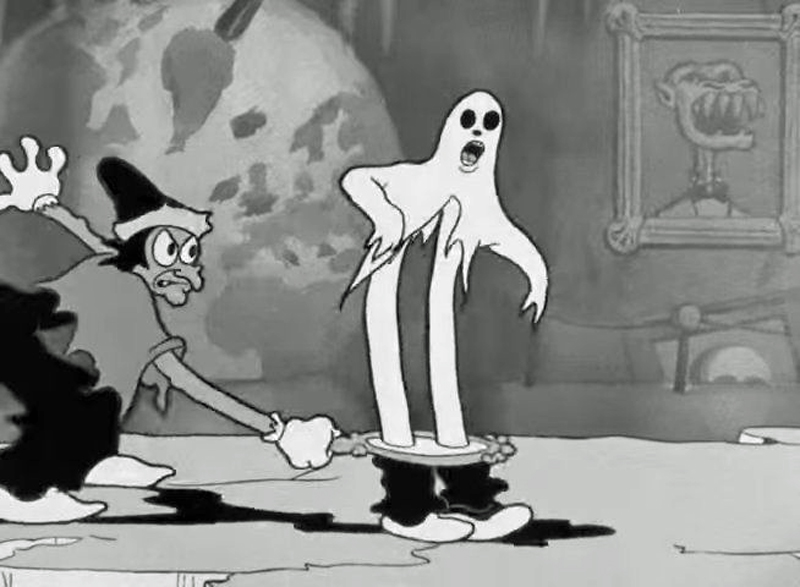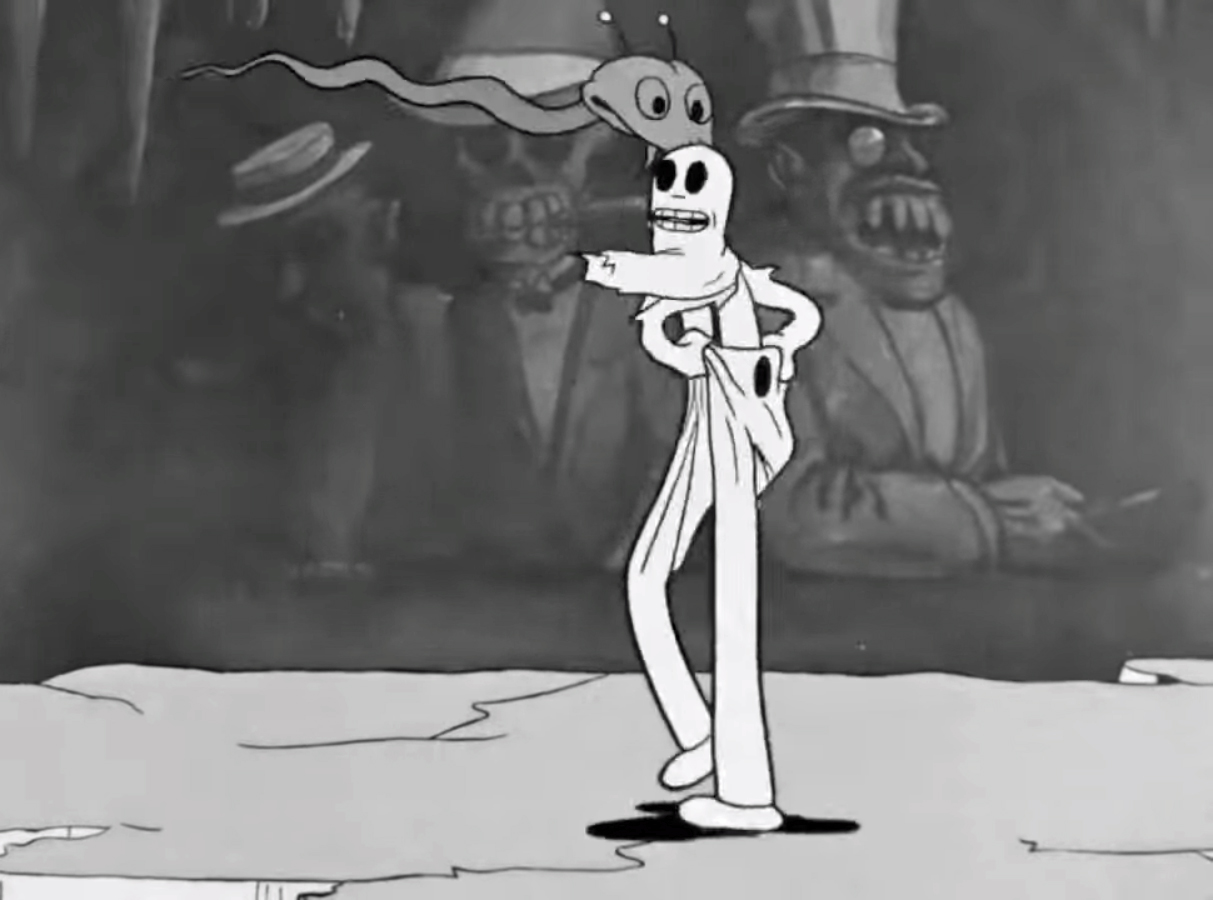 Emily LaBarge
Emily LaBarge
“That delicious character”: the shape-changing, fantastical world of the 1933 film.
Betty Boop: Snow White, directed by Dave Fleischer, animated by Roland C. Crandall, vocal chorus “St. James Infirmary Blues” sung by Cab Calloway, available on YouTube and the Internet Archive
• • •
Editor’s note: In light of the fact that movie theaters in New York City, where 4Columns is based, and other cities throughout the US remain closed during the coronavirus pandemic, we have invited our contributors to revisit films that are particularly significant to them and that are easily found online.
• • •
A world in which nothing is indifferent to us, nor we to it, imagine. In which a mirror sprouts arms with white-gloved hands and buffs a vain Queen’s nose with a small towel that it pulls from its backside. In which long icicles that hang over a doorway spontaneously curl themselves up and then down, like thick ribbons or locks of hair or muscled, alien fronds, and then grow faces to sing in chorus, her step-mama the Queen! In which a mouse pokes its head from the pocket of a pair of long johns spread as a red carpet for a curvaceous, black-clad, squeaky-voiced, enormous-headed woman, and raises its hat, hiya kid! In which suits of armor weep and dance, fall apart and tumble to the ground; benevolent trees liberate a woman bound to them with rope; and seven dwarves ski down a hill with their beards streaming behind them like wind socks. In which a clown named Koko, inspired by vaudeville and the costumes of German clowns and Bessie McCoy doing “The Yama Yama Man,” dances and sings and stretches and transforms—like he is made of rubber, like he is fluid, of some unholy substance, like he takes part in his own animation, like his graphic consistency is of another world entirely, which it is. Everything has life, is connected, ripples, reacts, full of possibility.
In 1926 Virginia Woolf wrote of early cinema’s potential to make visible “some secret language which we feel and see, but never speak,” asking: “Is there any characteristic which thought possesses that can be rendered visible without the help of words?” Prompted by a screening of The Cabinet of Dr. Caligari (1920), in which a strange shadow—an accident of projection—swells at the corner of the screen, bulges and quivers like a tadpole, Woolf conceives that emotions such as terror or anger might yield other forms, like “a black line wriggling upon a white sheet.” Richard Fleischer—son of Max, who with his brother Dave invented the rotoscope, the rotograph, and created Fleischer studios of Betty Boop and Popeye fame—recalls that he too was hypnotized by Caligari, the first film his father brought him to, at age seven: “Perhaps with this film, he was initiating me into the world in which he lived. His animated cartoons always relied heavily on surrealism for their effect.”

Betty Boop: Snow White.
Notable fans of Betty Boop include Theodor Adorno, who lamented the ascendance of Disney’s Donald Duck over Betty’s darker, more tragic and subversive form; Jean-Paul Sartre, who is rumored to have scoured the cinemas of Paris for a glimpse; and Simone de Beauvoir, who described her as “that delicious character . . . whose charms struck the New York censors as so disturbing that they condemned her to death.” Betty Boop: Snow White (1933) was made a year before Betty’s death at the hands of the Hays Code, which, for “moral” purposes, supplanted her cleavage, curls, garter, gangster-dog-boyfriend Bimbo, clown-pal Koko, and working girl independence with a house, high neckline, apron, puppy, domestic chores, and the ever-dull Grampy. In the short and beguiling film, she has the most wild and hallucinatory funeral a girl frozen between life and death in a coffin made of ice—in suspended animation!—could ask for.

Betty Boop: Snow White.
Having escaped the clutches of her jealous stepmother, Betty nonetheless (and as per the hapless theme of all her cartoons) stumbles into trouble and finds herself ferried through the underworld by her seven bearded friends, with the evil Queen—now a haggy, hook-nosed witch—in pursuit, clawing the air with her witchy hands in time to the beat of a piano and a bass. Betty has all but disappeared, her ice coffin is offstage right, and the image is now occupied by Koko, first in his regular form and then—changed by the Witch-Queen who passes her looking glass over the length of his body, as if threading a needle—as a pale, shaggy, undulating, dark-eyed ghoul of himself. Koko also is and is not Cab Calloway, whose voice radiates from the clown’s sinuous body, singing the mournful “St. James Infirmary Blues” as he cakewalks and shimmies and slides through the mystery cave, its ragged ground moving slowly like a conveyor belt beneath him.

Betty Boop: Snow White.
Music is literally what gives this animation its motion—characters run, bob, waltz, twirl, bounce, swell, shrink, transform, hoot, holler in time with the soundtrack, perfectly synched by a device called the “cue-meter.” It also signals the transitions between different spheres of being: when you hear that wah-wah of the trumpet with its stem-in Harmon mute, or the minor-keyed chorus of horns, you know a dark evolution is about to take place. In Betty Boop: Snow White, these sounds usher in Koko’s mesmeric song, which tells of his baby stretched out on a long white table / She so sweet, so cold, so fair, and imagines his own funeral, the details of which in turn act upon his animated body. Bury me in my straight-leg britches, for instance, sees a pair of ghostly trousers run down Ko Ko’s flexile legs, sliding all the way to the ground, only to be pulled back up by an extra pair of hands sprung from beneath his tattered shirt. When the pants reach his shoulders, a pair of eyeballs pop into Koko’s previously hollow sockets, rolling gleefully.

Betty Boop: Snow White.
The animated worlds of the Fleischer brothers propose that a shape-changing, fantastical, perhaps even utopian alterity might hover everywhere beneath the surface of our material realm and its technologies. All that is solid melts (sometimes into air!), gravity is levity, disfiguration is freedom, chaotic visual gags transport, and ceaseless propulsion is the order of the day. Walter Benjamin, no stranger to altered states, and Sergei Eisenstein both wrote about the promise offered by early cartoons. For Eisenstein, it lay in the “plasmaticness” of the figures that behave “like the primal protoplasm, not yet possessing a ‘stable’ form, but capable of assuming any form.” For Benjamin, it was the relationship between individual experience and collective form. “Film has launched an attack against the old Heraclitean truth, that in waking we share a world while sleeping we are each in separate worlds,” he wrote, and creations like Mickey Mouse, or Betty Boop, are figures, emanations of “the collective dream.”
As with all fantasies, the real-world evolution of this collective dream was not without its cruelties, such as the Taylorized animation workforce, with the lowest paid often women who painstakingly cut and colored individual animation cells. Or the infringement lawsuit brought against Max Fleischer and Paramount by Helen Kane, a performer whose act inspired Betty, and who in turn may have ripped part of it off—that famous Boop-Oop-a-Doop—from a Black performer by the name of Little Baby Esther. (Kane lost, and both women remained uncredited and disenfranchised, dying in relative obscurity, while Betty’s fame lives on.) But in the present moment of fatigue, like the weary population Benjamin speaks of in “Experience and Poverty”—written the year Betty Boop: Snow White was made—“to whom the purpose of existence seems to have been reduced to the most distant vanishing point of an endless horizon,” I like to think of how we might all live and sleep and dream together, finally not as apart or indifferent as we imagine.
Emily LaBarge is a writer based in London, where she teaches at the Royal College of Art. She has written for Artforum, Bookforum, frieze, the White Review, Granta, and the Paris Review, among other publications. She is the London correspondent for the Montreal-based quarterly, esse arts + opinions.